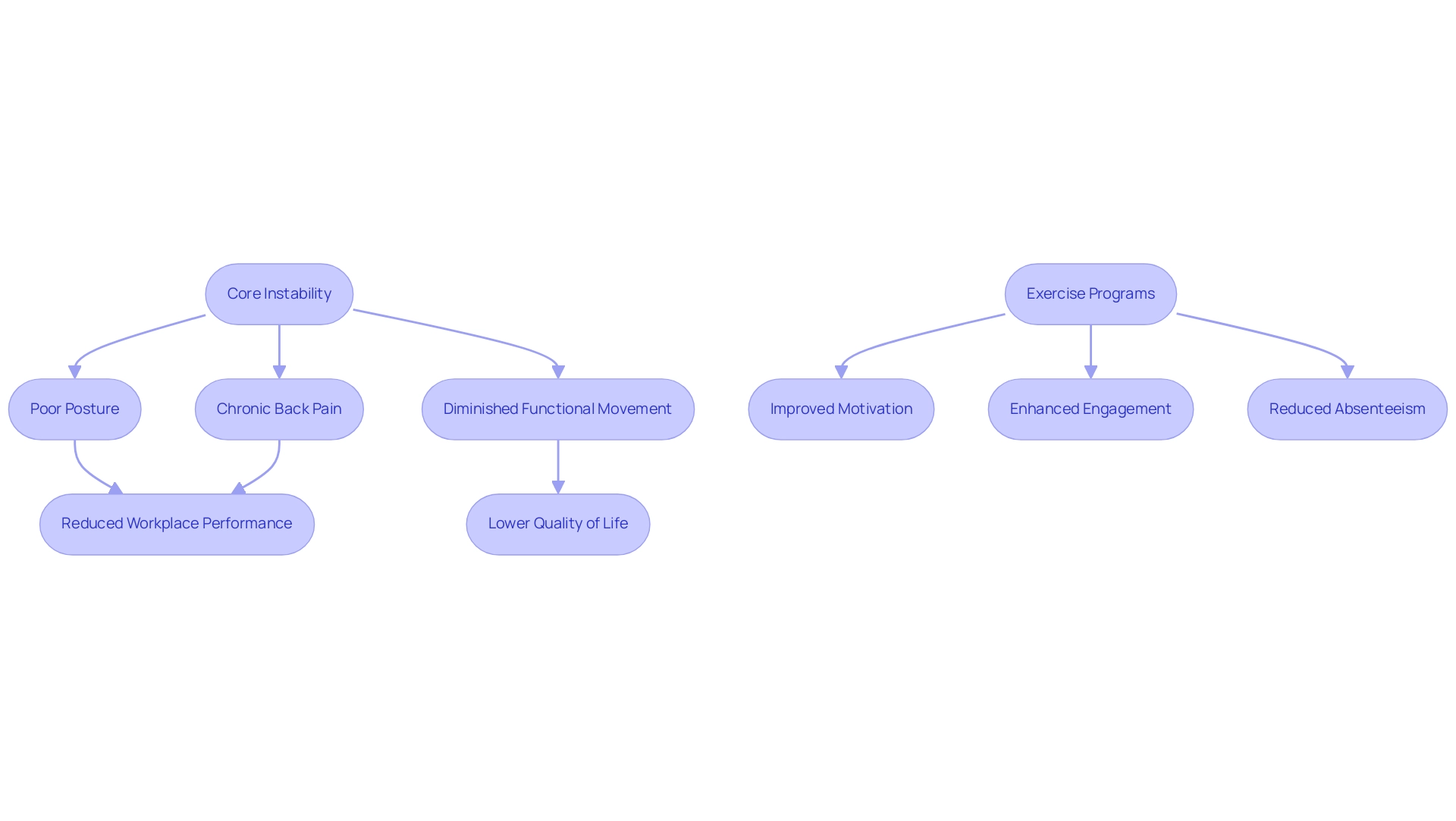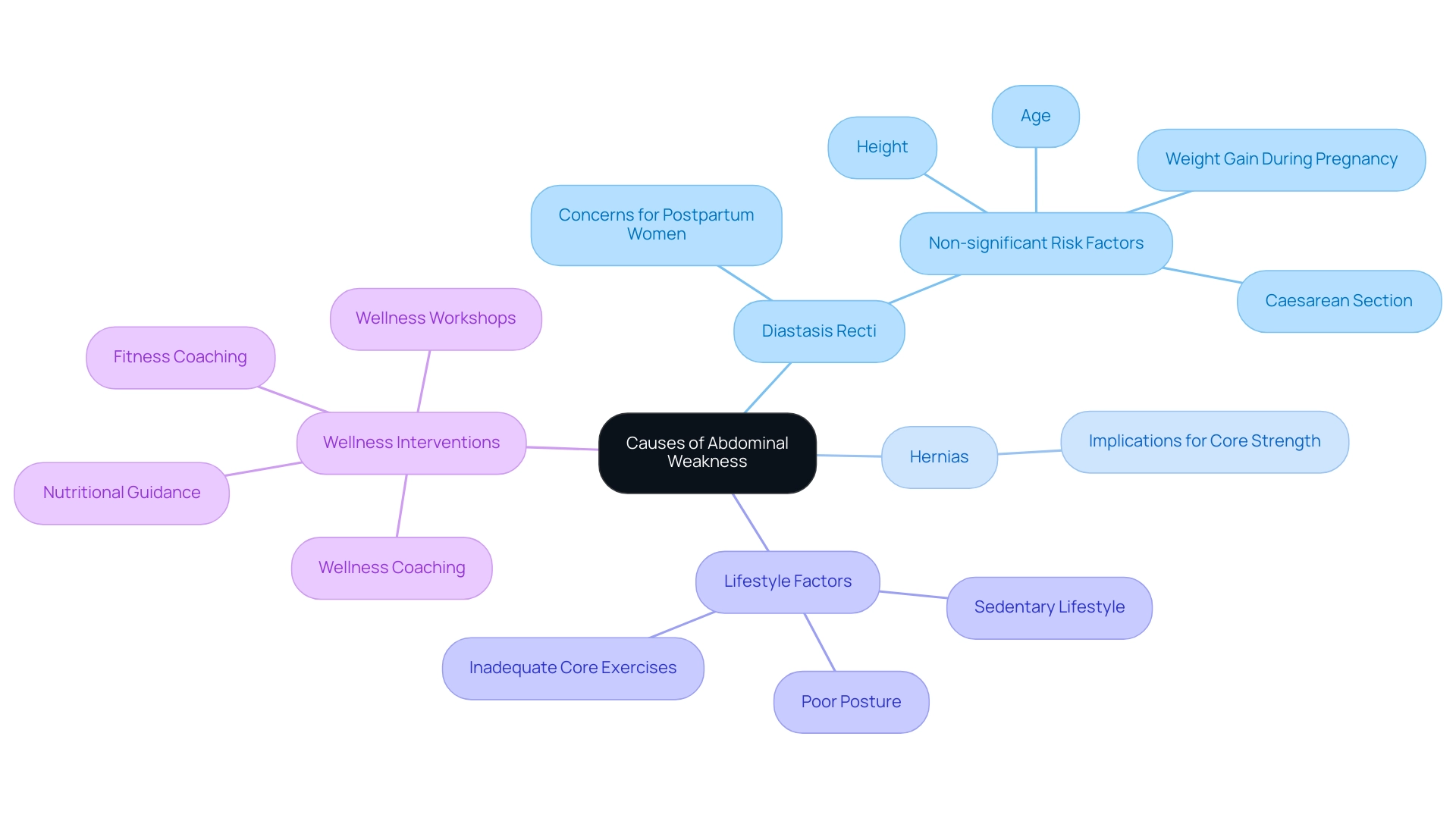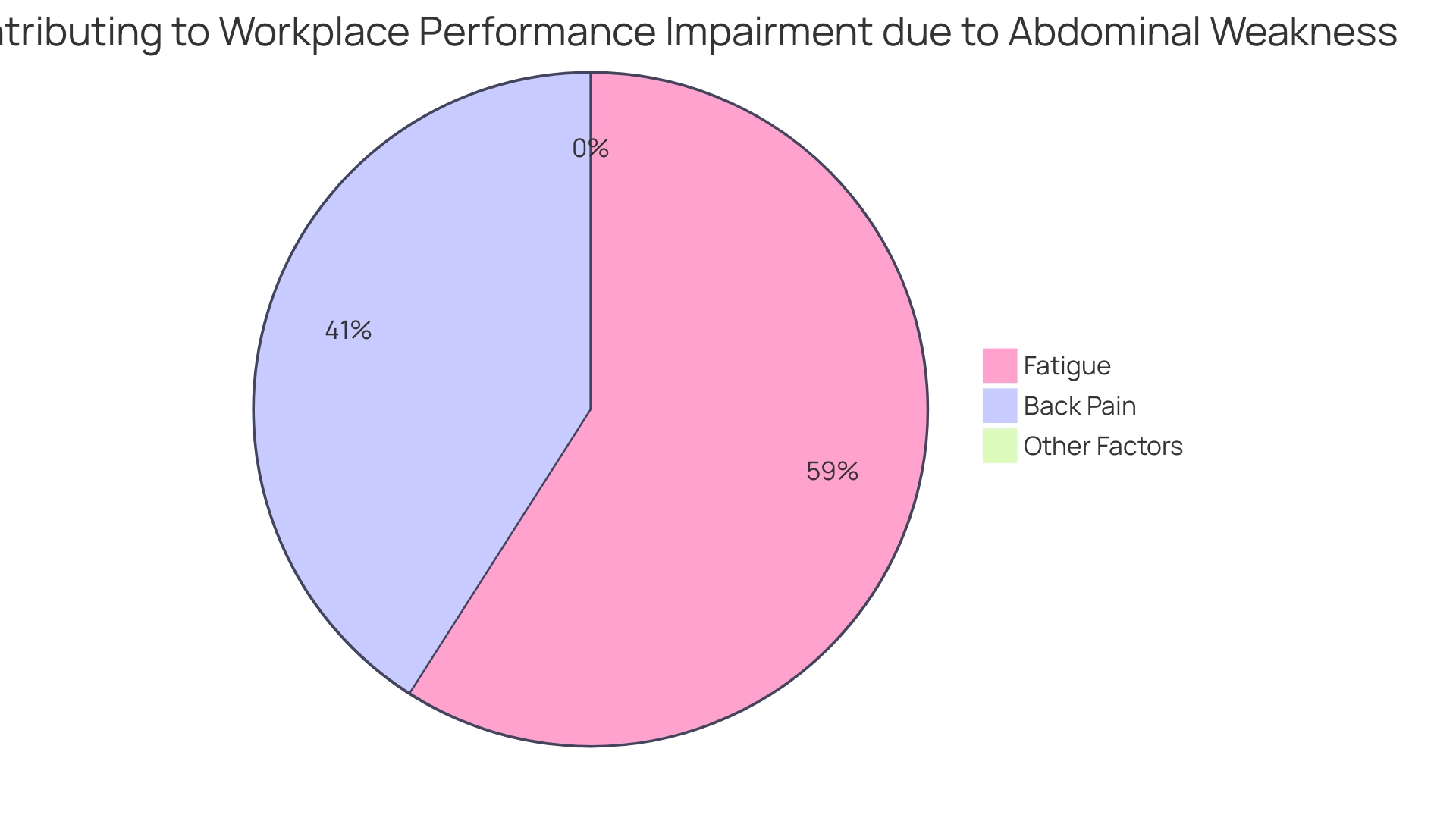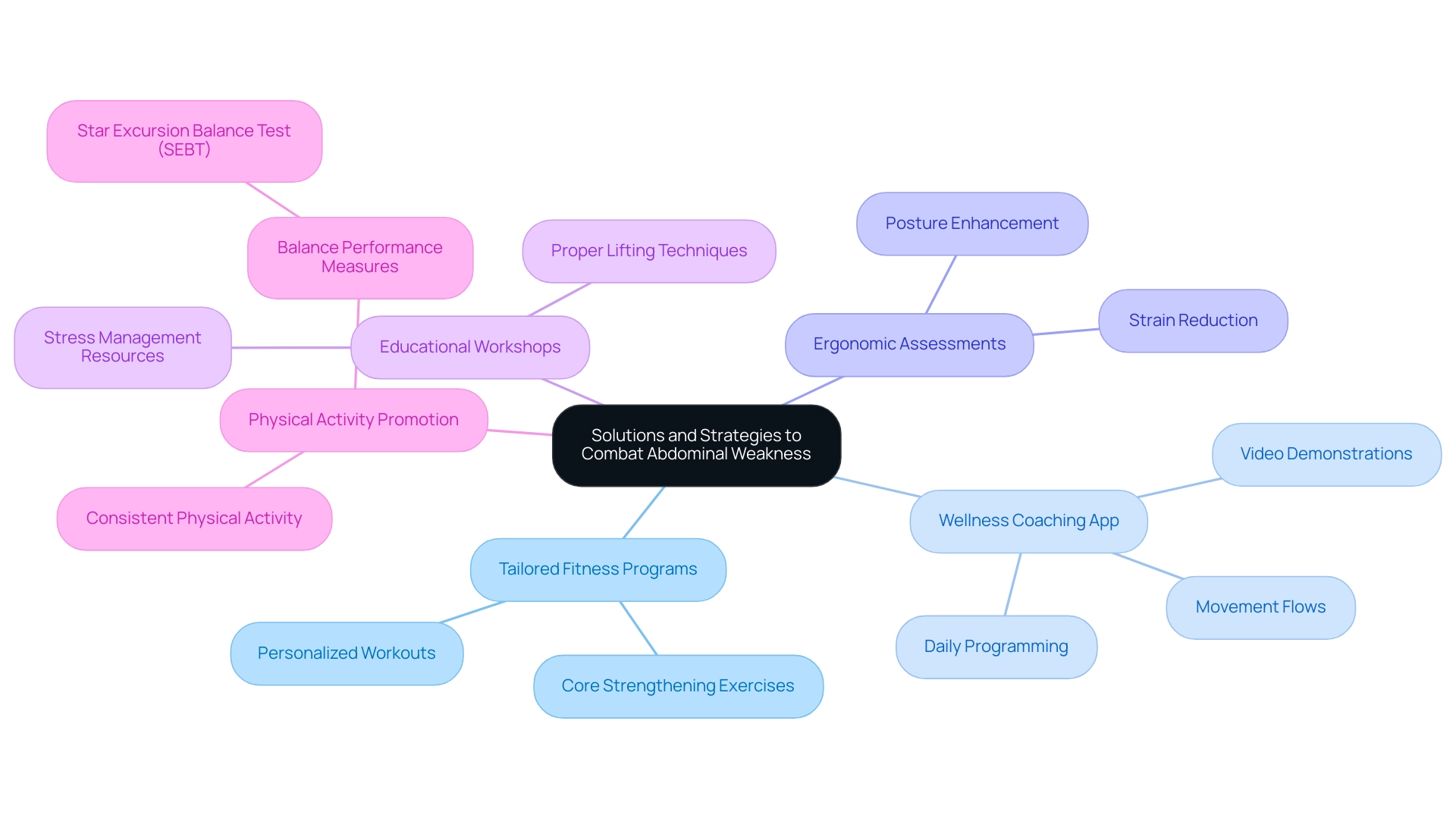Introduction
Abdominal weakness is often an overlooked issue that can significantly impact both individual well-being and workplace productivity. As employees struggle with pain and discomfort stemming from weak core muscles, the repercussions can ripple through an organization, leading to decreased performance and increased absenteeism.
With staggering statistics revealing a direct correlation between abdominal strength and chronic issues like low back pain, it becomes imperative for HR Benefits Managers to prioritize initiatives that bolster employee health. By implementing targeted wellness programs and promoting regular physical activity, organizations can not only enhance their team’s physical condition but also foster a more engaged and motivated workforce.
Understanding the causes and implications of abdominal weakness is the first step toward creating a healthier, more productive work environment that benefits everyone involved.
Defining Abdominal Weakness: What It Means and Why It Matters
Core instability is defined by a decrease in strength and stability within the stomach muscles, resulting in poor posture, chronic back pain, and diminished functional movement. This often underestimated condition plays a crucial role in maintaining overall physical health and workplace performance. Recent research shows that an astonishing 21.1% of participants surveyed reported experiencing low back pain, significantly linked to core instability.
Significantly, a study of 362 college females discovered that:
- 21% experienced low back pain
- 47.3% demonstrated a lack of strength in trunk flexors
- 52.6% demonstrated a lack of strength in trunk rotators
These findings underscore the urgent need to address abdominal weakness, since it has a direct impact on daily activities, workplace productivity, and overall quality of life. Moreover, regular exercise has been shown to enhance motivation among staff, reducing fatigue and stress while promoting positive emotions.
For instance, a study published in the journal 'Workplace Health & Safety' found that individuals who participated in workplace exercise programs reported feeling more motivated and engaged in their work. Hiroyuki Tsuchiya from the Department of Orthopedic Surgery emphasizes that abdominal weakness in trunk muscles is linked with chronic low back pain and an increased risk of falling, particularly in older women. Additionally, organizations with workplace exercise programs report improved staff motivation, engagement, and reduced absenteeism.
By acknowledging the significance of core strength and encouraging regular exercise, organizations can implement proactive steps to improve employee well-being, cultivate a healthier work environment, and ultimately benefit everyone.

Exploring the Causes of Abdominal Weakness: From Diastasis Recti to Hernias
Abdominal weakness can result from several factors, including diastasis recti, which is a condition particularly concerning for postpartum women due to the separation of the stomach muscles. This highlights a critical need for targeted interventions. Research indicates that factors such as age, height, weight gain during pregnancy, and caesarean section do not significantly influence the risk of diastasis recti, making tailored solutions essential.
Additionally, hernias, which occur when organs push through openings in the stomach wall, can further compromise core strength and lead to abdominal weakness. Statistics indicate that the average satisfaction with midsection appearance is notably low among vulnerable populations, emphasizing the necessity of strengthening core muscles. Sedentary lifestyles, poor posture, and inadequate core strengthening exercises also play significant roles in contributing to abdominal weakness.
By utilizing extensive wellness coaching services such as those provided by Foresight Health Coaching, organizations can adopt effective strategies to improve core strength. These customized programs, including fitness coaching, nutritional guidance, and wellness workshops, empower employees to achieve improved well-being outcomes. Such an approach not only fosters individual well-being but also enhances overall workplace performance, creating a healthier, more productive work environment.
Furthermore, insights from case studies reveal that weight gain, education, and parity significantly impact core strength, underscoring the importance of addressing these health issues proactively. For more detailed information on our membership options and to explore our user manuals and FAQs, please contact us directly. Get Started with Foresight today to craft a wellness plan that truly suits your needs.

The Impact of Abdominal Weakness on Workplace Performance
Abdominal instability presents a significant challenge to workplace performance, resulting in decreased productivity, increased absenteeism, and rising healthcare costs. Studies indicate that individuals with core instability frequently experience discomfort and pain, which significantly restricts their capacity to perform tasks efficiently. Alarmingly, statistics reveal that conditions such as fatigue (69.6%) and back pain (48.3%) are major contributors to work impairment, underscoring the urgent need to focus on core wellness.
The effect goes beyond short-term productivity; long-lasting concerns associated with abdominal weakness can significantly influence worker morale and job fulfillment. For instance, a study titled 'Demographic Factors in Productivity Loss' found that workers aged 30 to 40 experience the highest productivity losses, with women and those who are separated, divorced, or widowed facing more significant challenges compared to their married counterparts. Recognizing the direct correlation between abdominal health and abdominal weakness in workplace performance is essential.
By partnering with Foresight Health Coaching, organizations can implement targeted wellness programs that promote core strength and overall fitness. Our services encompass:
- Personalized fitness evaluations
- Customized workout plans
- Continuous support to ensure individuals are engaged and motivated
Such initiatives not only enhance employee well-being but also drive organizational success, establishing a win-win scenario for both employees and management.
Utilizing frameworks such as the WHO Healthy Workplace Framework and Model, as mentioned by Mo-Yeol Kang from the Department of Occupational and Environmental Medicine, enables companies to tackle these wellness issues proactively. This approach can lead to improved outcomes, reducing the healthcare costs associated with absenteeism and productivity loss. By investing in the well-being of their workforce through tailored corporate wellness programs, organizations can cultivate a motivated and engaged team.
Ready to take the next step? Arrange a consultation with Foresight Health Coaching today to discover how we can enhance your team’s well-being and productivity.

Solutions and Strategies to Combat Abdominal Weakness
To effectively combat abdominal weakness, organizations can adopt a multifaceted approach that includes tailored fitness programs emphasizing core strengthening exercises. Our wellness coaching app offers a comprehensive solution, providing personalized workouts and nutrition guidance that have shown significant benefits for patients with chronic non-specific low back pain. For instance, the randomized controlled trial titled 'Core Stability and Hip Exercises for Non-Specific Low Back Pain' reported improvements in physical function and activity levels among participants across various age ranges.
Our app eliminates the hassle of searching for different wellness resources, featuring daily programming to keep users on track with their goals, ensuring they can easily access personalized workouts and lessons whenever and wherever they are. The video demonstrations and workouts cater to visual learners, allowing them to see exercises in action before trying them out themselves. With movement flows integrated into the wellness app, users can keep their bodies moving and feeling great.
Conducting ergonomic assessments can enhance posture and reduce strain, while educational workshops on proper lifting techniques promote safe practices. Promoting consistent physical activity and supplying resources for stress management are vital elements that enhance overall well-being in the core region. As noted by Anant et al., significant improvements in lateral trunk strength and reductions in abdominal weakness can be achieved through targeted interventions.
Incorporating balance performance measures, such as the Star Excursion Balance Test (SEBT), can further enhance the effectiveness of these programs. By fostering a culture of wellness and well-being through our user-friendly application, organizations not only improve their employees' physical condition but also boost engagement and productivity, resulting in a more unified and resilient workforce. Implementing these strategies not only addresses immediate health concerns but also positions the organization as a leader in workplace wellness.
Sign Up Today.

Conclusion
Addressing abdominal weakness is not merely an individual concern; it is a pivotal factor that influences workplace productivity and employee well-being. The evidence presented highlights how weak core muscles can lead to chronic issues such as back pain, diminished functional movement, and increased absenteeism. By recognizing these challenges, HR Benefits Managers can take proactive steps to implement targeted wellness programs that enhance core strength and overall health.
Investing in comprehensive health coaching and tailored fitness initiatives not only empowers employees to improve their physical condition but also fosters a culture of engagement and motivation within the workplace. Organizations that prioritize abdominal health can expect to see a reduction in healthcare costs, increased employee morale, and enhanced productivity.
In conclusion, the path to a healthier, more productive work environment begins with a commitment to understanding and addressing abdominal weakness. By cultivating a proactive approach to employee wellness, organizations can create a supportive atmosphere that benefits everyone, ultimately leading to a more resilient and engaged workforce. Now is the time to take action and prioritize initiatives that will transform the workplace for the better.




